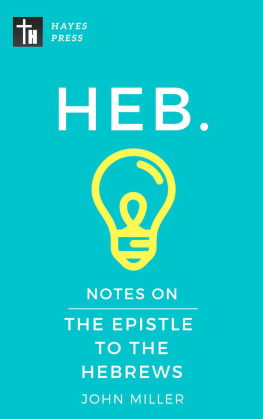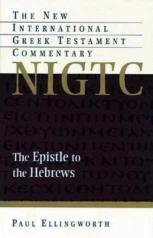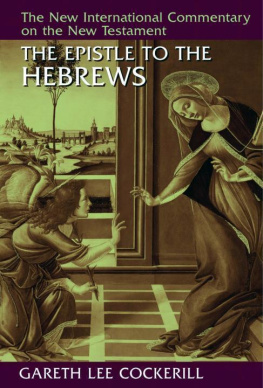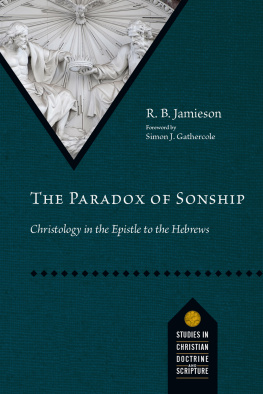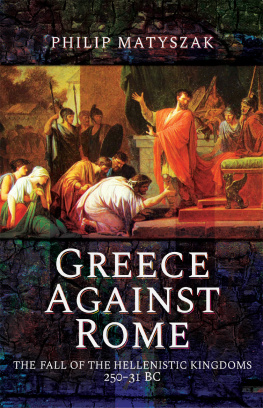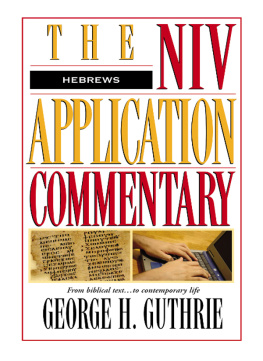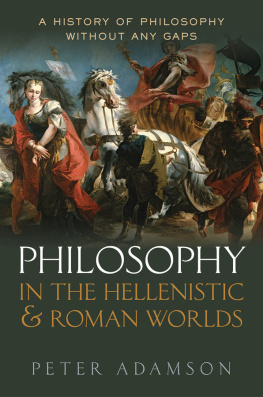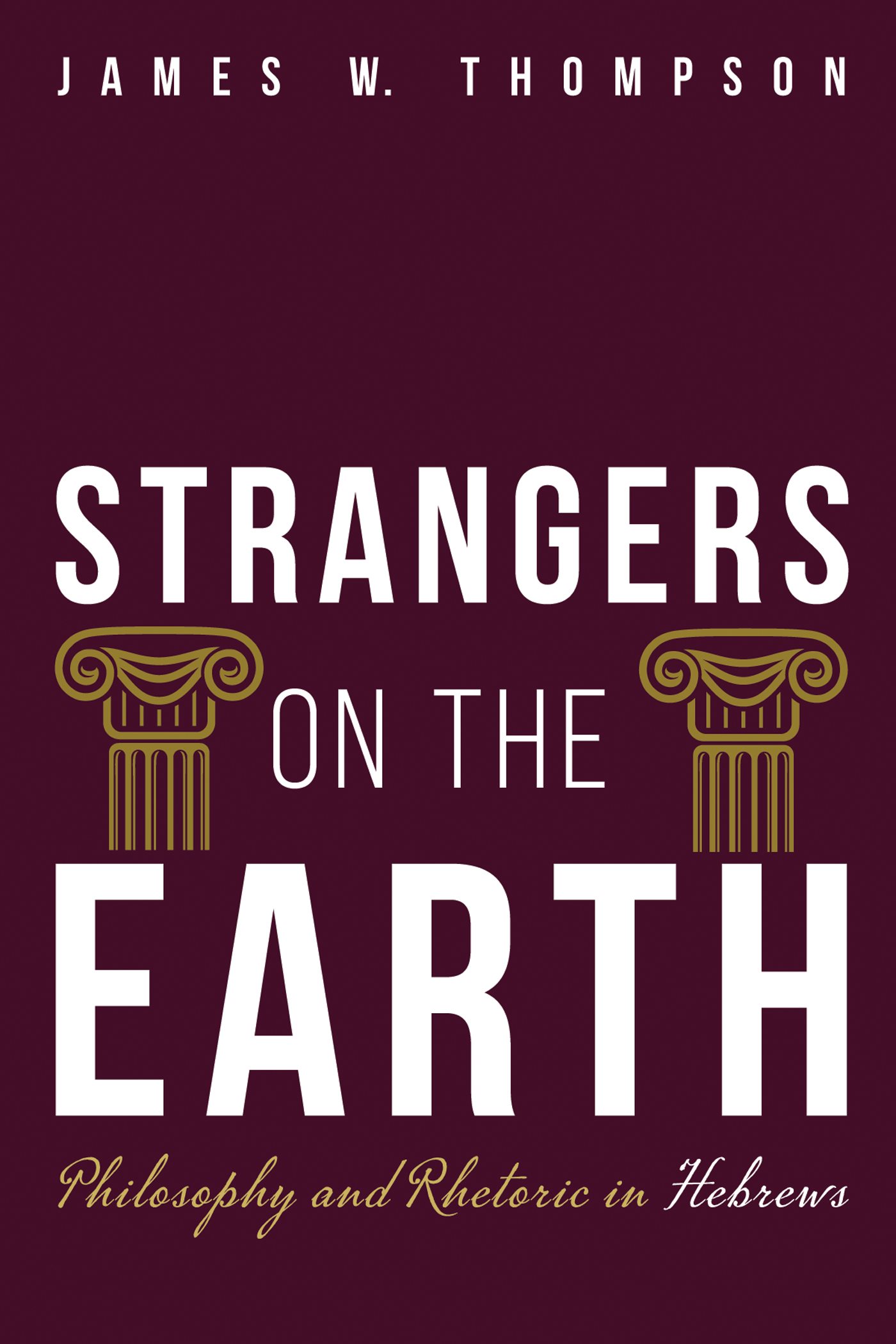Copyright 2020 James W. Thompson. All rights reserved. Except for brief quotations in critical publications or reviews, no part of this book may be reproduced in any manner without prior written permission from the publisher. Write: Permissions, Wipf and Stock Publishers, W. th Ave., Suite , Eugene, OR 97401 .
W. th Ave., Suite
Names: Thompson, James W. (James Weldon), 1942 , author.
Title: Strangers on the earth : philosophy and rhetoric in Hebrews / by James W. Thompson.
Description: Eugene, OR: Cascade Books, 2020 | Includes bibliographical references.
Identifiers: isbn 978-1-5326-8401-2 ( paperback ) | isbn 978-1-5326-8402-9 ( hardcover ) | isbn 978-1-5326-8403-6 ( ebook )
Subjects: LCSH: BibleHebrewsCriticism, interpretation, etc. | Hellenistic culture and society | Hellenism
Manufactured in the U.S.A. 04/14/20
PREFACE
U nless otherwise noted, translations of Philo and Plutarch are from the Loeb Classical Libra ry: Phi lo with an English Translation , translated and edited by F. H. Colson and G. H. Whitaker ( vols.; Cambridge: Harvard University Press, 1962); Plutarchs Moralia , translated and edited by Frank Cole Babbitt ( vols.; Cambridge: Harvard University Press, 1962 ).
Translation of the church fathers, unless otherwise noted, are from The Anti-Nicene Fathers: The Writings of the Fathers Down to A.D. ( vols.; Edinburgh: T. & T. Clark, 186773 ).
All abbreviations are taken from the SBL Handbook of Style .
INTRODUCTION
THE STRANGE NEW WORLD
OF HEBREWS
I n my monograph The Beginnings of Christian Philosophy I observed that the reader of Hebrews enters a strange new world that distinguishes it from other NT writings. I had first observed the unique character of this work during my graduate studies, when I turned to Hebrews after working with Pauline letters and the apocalyptic literature of the period. These observations led to the research in my dissertation, That Which Abides: Some Metaphysical Assumptions in the Epistle to the Hebrews , which I completed in 1974 . My continued analysis led to the publication of the monograph in 1982 , in which I expanded on the subject and traced the same themes. This collection of essays reflects my continued engagement with the strange new world of Hebrews after the completion of the earlier publication.
Previous scholars had observed the anomalous character of Hebrews. Franz Overbeck once declared that Hebrews is like Melchizedek, a book without a family of origin, These unique features have occupied scholars for generations.
The distinctive feature that has occupied my research is a method of argumentation that is also without parallel in the NT. This homily includes a series of synkrises comparing Christ and the Christ event with OT people and institutions. While synkrisis is a common rhetorical device, ( : ; : ; : ; cf. , : ; : ) , while the many Levitical priests are continually replaced (:) and the sacrifices on earth are continually repeated (:).
The author does not speak with apostolic or prophetic authority, but makes rational arguments, punctuating his claims with terms that are familiar to one who is schooled in rhetoric but largely absent from other NT writings. Indeed, he describes the Christ event with terms that were common in Greco-Roman rhetoric. It was fitting () for God to redeem the people through Jesus Christ (:; :). Where there is a covenant, it is necessary () for a death to occur (:), and it was necessary () that the heavenly sanctuary be cleansed (:). The ancient sacrifices were ineffective because it is impossible ( ) for the blood of bulls and goats to take away sins (:). The author stands within a Christian tradition that proclaims the saving significance of the death of Jesus and his exaltation to Gods right hand but elaborates on this confession with assumptions and arguments that are unprecedented in the NT.
Because of the strangeness of this book, it has been resisted by some and neglected by others. With the exception of Tertullian, who welcomed its denial of a second repentance, Protestant scholars observed its distance from Pauls doctrine of justification and gave it little attention; it is barely noticed, for example, in Rudolf Bultmanns Theology of the New Testament .
Because of the letters consistent appeal to the two levels of reality and to rational argument, the intellectual milieu in which the argument would be persuasive becomes a major issue. Traditional interpretation had read Hebrews as a commentary on OT passages without considering a wider milieu. Scholarship in the past century has been sharply divided over the intellectual and religious background of Hebrews. Looking at the same evidence, some scholars maintain the deeply Jewish nature of the book with roots in Jewish apocalyptic literature while others interpret Hebrews against the background of Hellenistic thought.
These alternatives were especially evident for decades in the Protestant faculty at the University of Tbingen. In Das wandernde Gottesvolk , Ernst Ksemann correctly observed the central focus on the pilgrimage of the people of God to the heavenly city, attributing this motif to a gnostic influence. Otto Michel wrote the commentary on Hebrews in the Meyer series, which went through numerous editions, demonstrating the apocalyptic and rabbinic background to Hebrews. Ksemanns view of the gnostic background of Hebrews has not received many followers, but Michels view continues in current literature.
The major debate since the middle of the twentieth century has been over the alternative between Platonism, as represented primarily by Philo of Alexandria, and Jewish apocalyptic literature. Although Platonic influence on Hebrews had been suggested since the sixteenth century, Ceslas Spicqs monumental twentieth-century commentary argued for the influence of Philo on Hebrews, even suggesting that the author of Hebrews was a Philonist converted to Christianity.
In my dissertation and the research that followed, I acknowledged the fluidity of ancient intellectual traditions, recognizing that the alternative between apocalyptic and Platonic features was not satisfactory, for the two were blended in a variety of ways in antiquity. Nevertheless, I concluded that traditional Jewish apocalypses did not account for the distinctive metaphysical assumptions and rhetorical arguments in Hebrews. The focus on the two levels of reality and the stability of the heavenly world were commonplace in Middle Platonism, the philosophy that was incorporated into a variety of philosophical and religious systems in the Hellenistic age. Gnostic systems, the Hermetica , and numerous patristic writers incorporate elements of Middle Platonism, while Greek writers incorporated Middle Platonism into ancient myths.
The most prominent characteristic of Middle Platonism was the focus on the gap separating the transcendent, intelligible world, and the realm of sense perception. The transcendent world is stable and unchanging, while the realm of sense perception is subject to change and destruction. A wall separates these two worlds, but intermediate beings bridge the gap between the two realms. The deity is so separated from human language that it can be described only with negatives. The challenge for the individual is to see beyond the physical world and enter a relationship with the transcendent deity.



